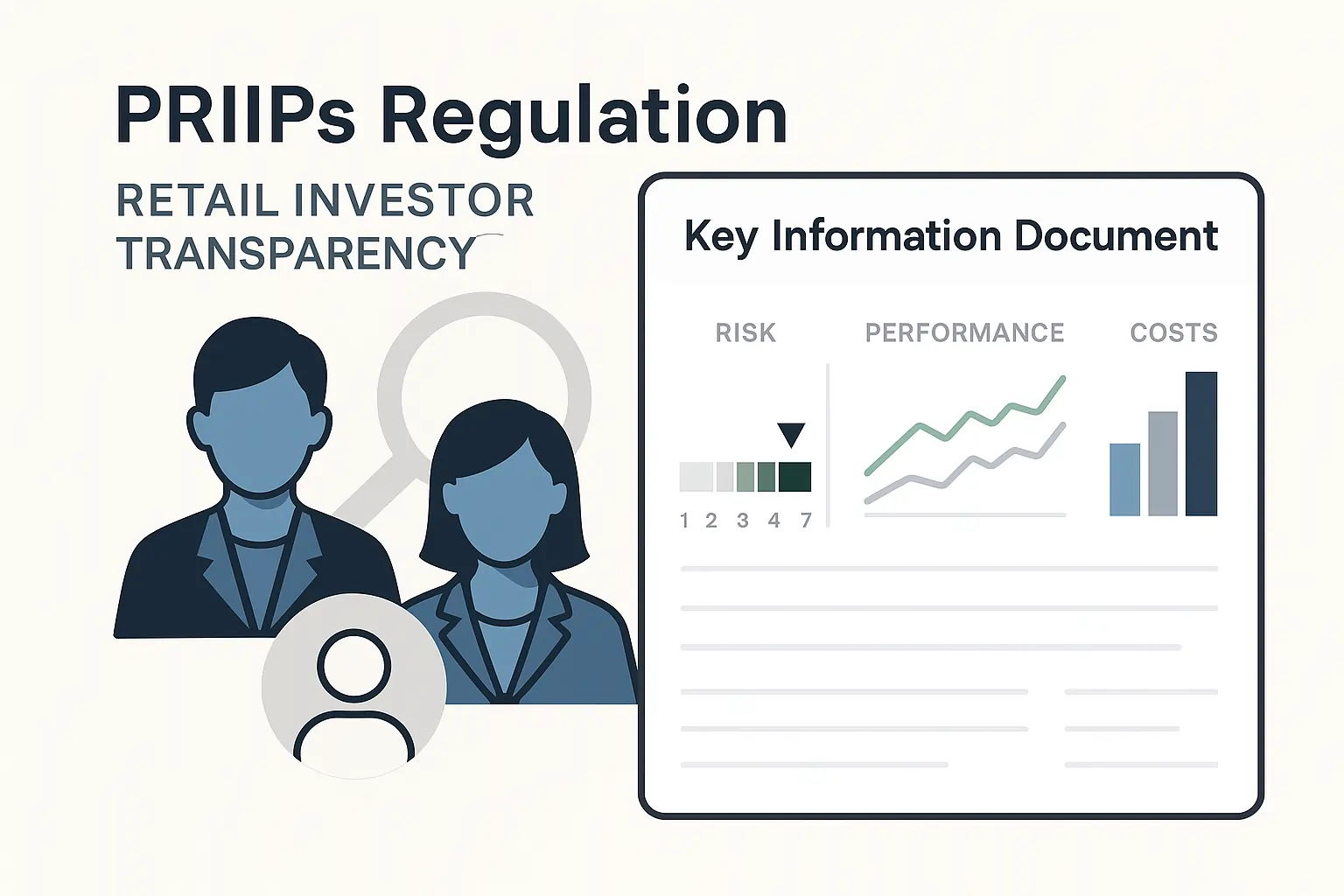What Is the PRIIPs Regulation?
The PRIIPs (Packaged Retail and Insurance-based Investment Products) Regulation is a European framework designed to enhance transparency for retail investors. Its primary goal is to ensure investors receive clear, comparable, and standardized information about financial products, enabling them to make more informed decisions based on risk, performance, and cost.
Since January 1, 2023, it has become mandatory for financial institutions offering investment products to retail clients to provide a standardized Key Information Document (KID) that adheres to specific Regulatory Technical Standards (RTS).
The Importance of the Key Information Document (KID)
The KID is a concise, three-page document that must accompany every PRIIP sold to a retail investor. It contains:
- A Summary Risk Indicator (SRI)
- Performance Scenarios
- Cost Disclosures
This document allows retail investors to compare different products, evaluate potential risks and returns, and understand the charges involved over time.
Key Components of the KID
Summary Risk Indicator (SRI)
The SRI is a numerical value between 1 (lowest risk) and 7 (highest risk), determined using two components:
- Credit Risk Measure (CRM): Based on external credit ratings.
- Market Risk Measure (MRM): Derived from the Value-at-Risk (VaR) Equivalent Volatility.
MRM is calculated using Cornish-Fisher expansion, which adjusts for skewness and kurtosis in the returns distribution to produce a more accurate volatility metric.
Performance Scenarios
Performance scenarios simulate potential returns under different market conditions:
- Favorable
- Moderate
- Unfavorable
- Stress
These scenarios are based on historical data and computed using a combination of rolling returns and statistical models.
- The Recommended Holding Period (RHP) plays a crucial role. For example, if a fund has an RHP of 5 years, data must be sourced from a 10-year period to perform calculations using both fixed and incrementally expanding windows.
- The Stress Scenario is computed using advanced statistical models, particularly the Cornish-Fisher expansion, to account for extreme events in the market.
Cost Methodology
The KID must include transparent cost disclosures:
- One-off and ongoing charges
- Reduction in yield due to costs
Costs are presented as an annual impact on returns, using simplified arithmetic rather than compound methodologies, for ease of comprehension by retail investors.
Operational and Compliance Challenges
Automation at Scale
Institutions managing hundreds of products must automate the creation of KIDs monthly. This includes:
- Data ingestion from market and legacy sources
- Error checking and alert systems
- Calculation of risk, performance, and cost metrics
Reporting Tools
Solutions like Amendis provide a full front-to-back solution:
- A robust calculation engine
- Audit trails for regulatory review
- Bilingual/multilingual KID generation using AI-driven translation tools
Preparing for 2026
By 2026, the European Commission plans several enhancements to the KID:
- Addition of an executive summary
- New ESG disclosures aligned with SFDR and EU taxonomy
- Interactive KIDs, allowing users to simulate different scenarios and holding periods via a web interface
Practical Implementation and Workflow Example
Automated Workflow
A typical workflow includes:
- Importing data (prices, ratings, etc.)
- Validating and cleaning data
- Computing SRI, performance scenarios, and cost impact
- Generating KID reports in multiple languages
- Publishing them on web portals
Alerts are generated at each step to ensure errors or anomalies are caught early—be it data inconsistencies or thresholds nearing a change in SRI level.
Client Portal and Future-Proofing
Amendis’ digital communication tool, Client Portal, provides:
- Dashboard access to KID metrics
- ESG data integration
- Scenario analysis based on different holding periods
It allows retail investors to navigate data more intuitively, compare funds, and better understand risks and returns in both amount and rate terms.
FAQs About PRIIPs Compliance
Why is the Stress Scenario sometimes equal to the Unfavorable Scenario?
While mathematically possible, regulations mandate a hierarchy. If the stress scenario yields a more favorable result than the unfavorable one, the unfavorable outcome takes precedence in the KID.
Why isn’t a date shown for the Stress Scenario?
The stress scenario is based on simulated, statistically derived outcomes—not real historical data—so no specific date applies.
What happens if a firm is non-compliant?
Failure to comply with PRIIPs can lead to significant financial penalties. Even though audits are not yet systematic, firms are strongly advised to ensure full regulatory adherence.
Final Thoughts
The PRIIPs regulation significantly enhances transparency in retail investment products by mandating standardized risk, performance, and cost reporting. While compliance requires advanced financial technology and operational robustness, platforms like Amendis make it feasible to automate, validate, and deliver high-quality KIDs at scale.
With upcoming regulatory changes in 2026, including interactivity and ESG alignment, firms must begin preparing now to stay ahead. Investing in scalable and flexible fintech solutions is not just a compliance necessity—it is a competitive advantage.
Discover More
For more insights into analyzing value and growth stocks poised for sustainable growth, consider this expert guide. It provides valuable strategies for identifying high-potential value and growth stocks.
We also have other highly attractive stocks in our portfolios. To explore these opportunities, visit our investment portfolios.
This analysis serves as information only and should not be interpreted as investment advice. Conduct your own research or consult with a financial advisor before making investment decisions.
Looking to Educate Yourself for More Investment Strategies?
Check out our free articles where we share our top investment strategies. They are worth their weight in gold!
📖 Read them on our blog: Investment Blog
For deeper insights into ETF investing, trading, and market strategies, explore our library or go to Lulu.com for each guide:
📘 ETF Investing: ETFs and Financial Serenity
📘 Technical Trading: The Art of Technical & Algorithmic Trading
📘 Stock Market Investing: Unearthing Gems in the Stock Market
📘 Biotech Stocks (High Risk, High Reward): Biotech Boom









0 Comments